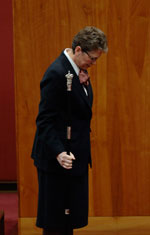49 Meeting of Senate
The bells shall be rung for 5 minutes prior to the time appointed for a meeting of the Senate, and the President shall then take the chair.
Amendment history
Adopted: 9 September 1909, J.120 as SO 51 (to take effect 1 October 1909)
Amended: 5 October 1922, J.107 (reference to the President taking the chair replaced with a reference to when the bells should be rung)
1989 revision: Old SO 52 renumbered as SO 49; material deleted in 1922 restored; expression streamlined
Commentary

At the commencement of the sitting, the President takes the chair, having been announced by the Usher of the Black Rod (Photo courtesy of AUSPIC)
This characteristic start to the parliamentary day was not part of the original code of practice adopted in 1903 but, as President Gould noted when the Senate adopted the new standing order in 1909,[1] it was customary to ring the bells and it had been done on the authority of the Chair to date. The new standing order was thought necessary “to obviate mistakes”.[2]
As adopted, the standing order provided:
The bells shall be rung for five minutes prior to the President taking the Chair.
There was no explanation for the replacement in 1922 of the reference to the President with “time appointed on each day fixed as a meeting day of the Senate” but it was a change that reinforced the Senate’s control over its own sittings.[3] The original form was susceptible to a misperception that the meeting time was at the discretion of the President but the amendment introduced a new disadvantage in that it left the standing order without its main action.
The 1989 revision restored the reference to the President’s taking the Chair, an action which marks the commencement of a meeting of the Senate.